ACC 707 Auditing & Assurance Services: Risk, Procedures and KAM
VerifiedAdded on 2023/04/23
|14
|3547
|381
Report
AI Summary
This report provides a detailed analysis of auditing and assurance services, focusing on risk assessment and substantive audit procedures. It examines the cases of Advanced Computer Solutions Limited and Green Machine Limited, identifying key assertions at risk, such as completeness and accurac...
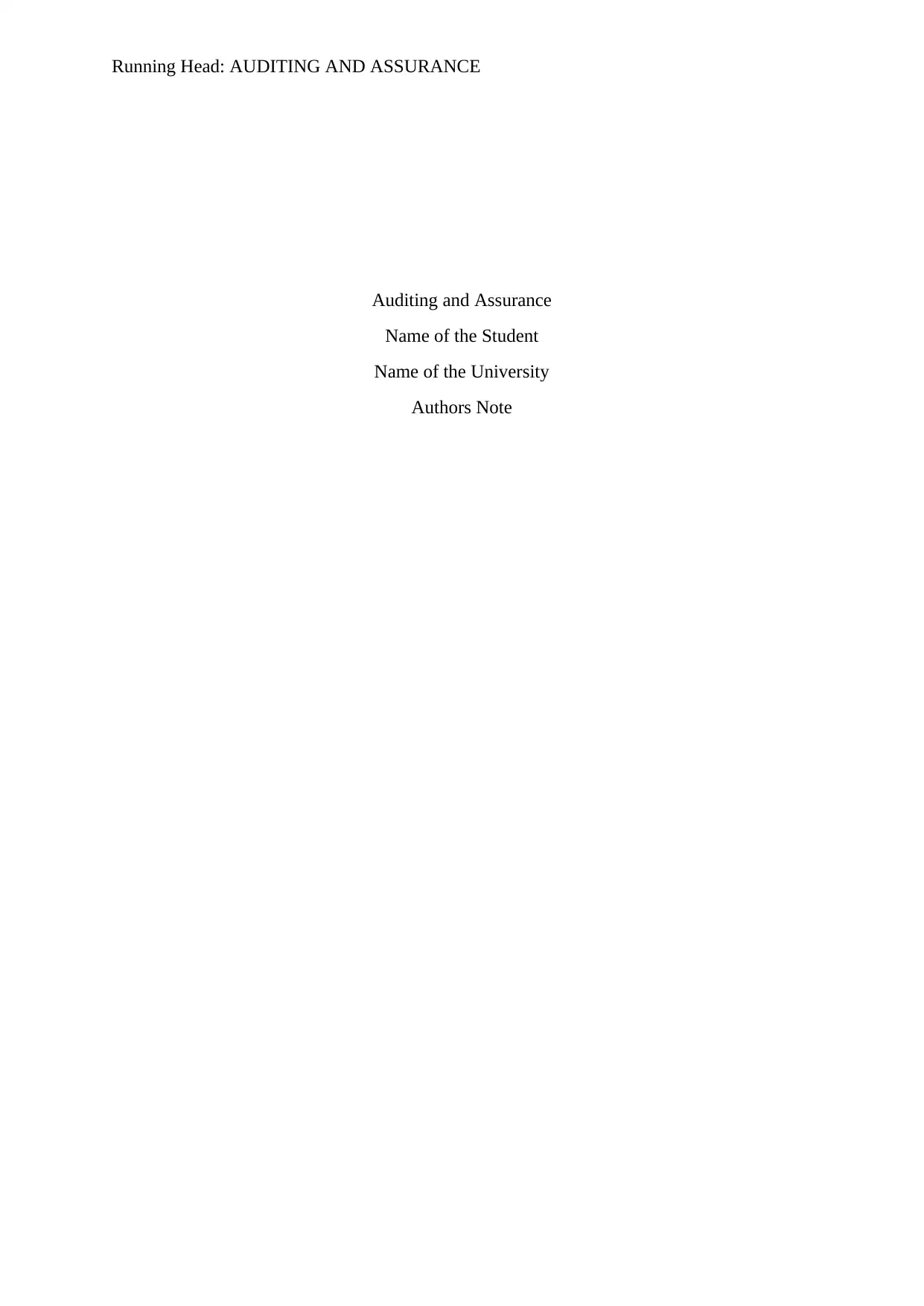
Running Head: AUDITING AND ASSURANCE
Auditing and Assurance
Name of the Student
Name of the University
Authors Note
Auditing and Assurance
Name of the Student
Name of the University
Authors Note
Paraphrase This Document
Need a fresh take? Get an instant paraphrase of this document with our AI Paraphraser

1AUDITING AND ASSURANCE
Table of Contents
Introduction................................................................................................................................2
Case of Advanced Computer Solutions Limited........................................................................2
Key Assertions at Risk...........................................................................................................2
Substantive Audit Procedures................................................................................................4
Case of Green Machine Limited................................................................................................5
Key Assertions at Risk...........................................................................................................5
Substantive Audit Procedures................................................................................................6
Key Audit Matters (KAM) as per ASA 701 Key Audit Matters...............................................7
Objectives...............................................................................................................................7
Definition:..............................................................................................................................7
Requirements to Determine KAM:........................................................................................7
Benefits of ASA 701 Key Audit Matters...............................................................................8
Reasons for selecting Key Audit Matters:.............................................................................9
Case study of Advance Computer Solution:..........................................................................9
Case study of Green Machines Ltd:.......................................................................................9
KAM disclosure under ASA 701 Key Audit Matters:.............................................................10
Conclusion:..............................................................................................................................10
References:...............................................................................................................................11
Table of Contents
Introduction................................................................................................................................2
Case of Advanced Computer Solutions Limited........................................................................2
Key Assertions at Risk...........................................................................................................2
Substantive Audit Procedures................................................................................................4
Case of Green Machine Limited................................................................................................5
Key Assertions at Risk...........................................................................................................5
Substantive Audit Procedures................................................................................................6
Key Audit Matters (KAM) as per ASA 701 Key Audit Matters...............................................7
Objectives...............................................................................................................................7
Definition:..............................................................................................................................7
Requirements to Determine KAM:........................................................................................7
Benefits of ASA 701 Key Audit Matters...............................................................................8
Reasons for selecting Key Audit Matters:.............................................................................9
Case study of Advance Computer Solution:..........................................................................9
Case study of Green Machines Ltd:.......................................................................................9
KAM disclosure under ASA 701 Key Audit Matters:.............................................................10
Conclusion:..............................................................................................................................10
References:...............................................................................................................................11

2AUDITING AND ASSURANCE
Introduction
Auditing is defined as the inspection of the financial reports along with the accounts
of business organization without considering the materialistic misstatements. The preparation
of audit report always makes sure that the auditors are reviewing the assertions from the end
of management (Gay and Simnett 2015). Conducting an audit report is incomplete if the
auditors are not considering the point of view of the management while taking into
consideration about the assertions for preparing the financial reports. Now if we discuss about
the audit assertions, these are nothing but the assumptions and important thought processes
that management of any company possess for implying it in the process of financial
reporting.
There is risk as well in these assertions which can create materialistic impact as well
on the financial reporting. Hence the auditors here plays a great role in identifying the risk
factors involved within these kinds of assertions that are taking place while managing the
financial accounts or reports. In case of Australian auditing methods, this is very crucial for
the auditors to follow the rules and principles of ASA 701 Communicating Key Audit
Matters in the Independent Auditor’s Report (Louwers et al. 2015). This particular scope of
work shows how to deal with the risk of the assertions in broader perspective and also it helps
them to record all the risk factors involved within the financial assertions happened in the
financial account or report. This above introduction to the assertions risk is elaborated from
different point views in this report and also this report is discussing about the key audit
matters for two particular situations.
Introduction
Auditing is defined as the inspection of the financial reports along with the accounts
of business organization without considering the materialistic misstatements. The preparation
of audit report always makes sure that the auditors are reviewing the assertions from the end
of management (Gay and Simnett 2015). Conducting an audit report is incomplete if the
auditors are not considering the point of view of the management while taking into
consideration about the assertions for preparing the financial reports. Now if we discuss about
the audit assertions, these are nothing but the assumptions and important thought processes
that management of any company possess for implying it in the process of financial
reporting.
There is risk as well in these assertions which can create materialistic impact as well
on the financial reporting. Hence the auditors here plays a great role in identifying the risk
factors involved within these kinds of assertions that are taking place while managing the
financial accounts or reports. In case of Australian auditing methods, this is very crucial for
the auditors to follow the rules and principles of ASA 701 Communicating Key Audit
Matters in the Independent Auditor’s Report (Louwers et al. 2015). This particular scope of
work shows how to deal with the risk of the assertions in broader perspective and also it helps
them to record all the risk factors involved within the financial assertions happened in the
financial account or report. This above introduction to the assertions risk is elaborated from
different point views in this report and also this report is discussing about the key audit
matters for two particular situations.
⊘ This is a preview!⊘
Do you want full access?
Subscribe today to unlock all pages.

Trusted by 1+ million students worldwide
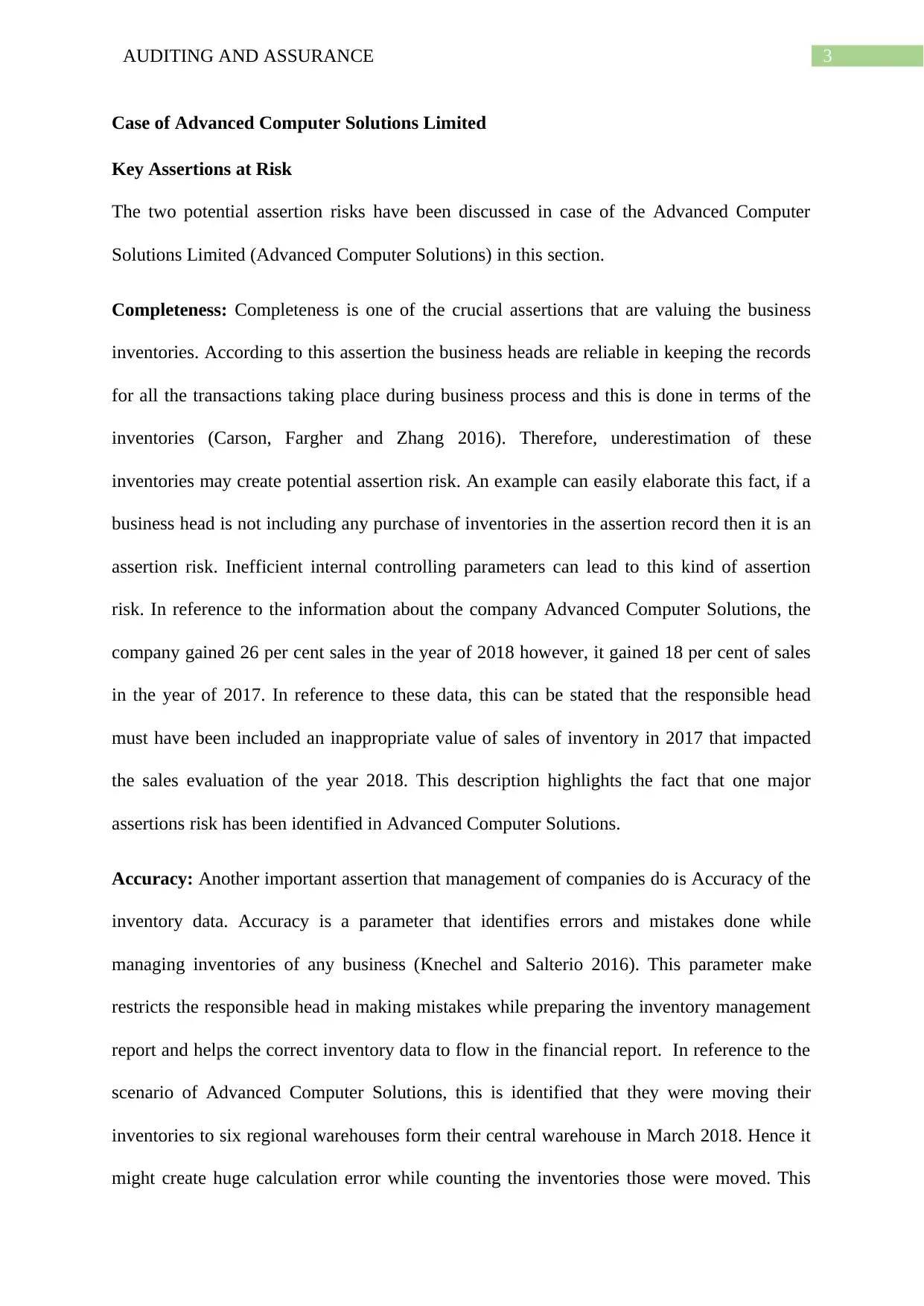
3AUDITING AND ASSURANCE
Case of Advanced Computer Solutions Limited
Key Assertions at Risk
The two potential assertion risks have been discussed in case of the Advanced Computer
Solutions Limited (Advanced Computer Solutions) in this section.
Completeness: Completeness is one of the crucial assertions that are valuing the business
inventories. According to this assertion the business heads are reliable in keeping the records
for all the transactions taking place during business process and this is done in terms of the
inventories (Carson, Fargher and Zhang 2016). Therefore, underestimation of these
inventories may create potential assertion risk. An example can easily elaborate this fact, if a
business head is not including any purchase of inventories in the assertion record then it is an
assertion risk. Inefficient internal controlling parameters can lead to this kind of assertion
risk. In reference to the information about the company Advanced Computer Solutions, the
company gained 26 per cent sales in the year of 2018 however, it gained 18 per cent of sales
in the year of 2017. In reference to these data, this can be stated that the responsible head
must have been included an inappropriate value of sales of inventory in 2017 that impacted
the sales evaluation of the year 2018. This description highlights the fact that one major
assertions risk has been identified in Advanced Computer Solutions.
Accuracy: Another important assertion that management of companies do is Accuracy of the
inventory data. Accuracy is a parameter that identifies errors and mistakes done while
managing inventories of any business (Knechel and Salterio 2016). This parameter make
restricts the responsible head in making mistakes while preparing the inventory management
report and helps the correct inventory data to flow in the financial report. In reference to the
scenario of Advanced Computer Solutions, this is identified that they were moving their
inventories to six regional warehouses form their central warehouse in March 2018. Hence it
might create huge calculation error while counting the inventories those were moved. This
Case of Advanced Computer Solutions Limited
Key Assertions at Risk
The two potential assertion risks have been discussed in case of the Advanced Computer
Solutions Limited (Advanced Computer Solutions) in this section.
Completeness: Completeness is one of the crucial assertions that are valuing the business
inventories. According to this assertion the business heads are reliable in keeping the records
for all the transactions taking place during business process and this is done in terms of the
inventories (Carson, Fargher and Zhang 2016). Therefore, underestimation of these
inventories may create potential assertion risk. An example can easily elaborate this fact, if a
business head is not including any purchase of inventories in the assertion record then it is an
assertion risk. Inefficient internal controlling parameters can lead to this kind of assertion
risk. In reference to the information about the company Advanced Computer Solutions, the
company gained 26 per cent sales in the year of 2018 however, it gained 18 per cent of sales
in the year of 2017. In reference to these data, this can be stated that the responsible head
must have been included an inappropriate value of sales of inventory in 2017 that impacted
the sales evaluation of the year 2018. This description highlights the fact that one major
assertions risk has been identified in Advanced Computer Solutions.
Accuracy: Another important assertion that management of companies do is Accuracy of the
inventory data. Accuracy is a parameter that identifies errors and mistakes done while
managing inventories of any business (Knechel and Salterio 2016). This parameter make
restricts the responsible head in making mistakes while preparing the inventory management
report and helps the correct inventory data to flow in the financial report. In reference to the
scenario of Advanced Computer Solutions, this is identified that they were moving their
inventories to six regional warehouses form their central warehouse in March 2018. Hence it
might create huge calculation error while counting the inventories those were moved. This
Paraphrase This Document
Need a fresh take? Get an instant paraphrase of this document with our AI Paraphraser

4AUDITING AND ASSURANCE
calculation error can reduce the inventory turnover of 3.8 in 2018 from 5.4 in 2017. Hence
this is considered as one of the important assertion risk for inventory evaluation in Advanced
Computer Solutions.
Substantive Audit Procedures
This is identified form the above discussion about Advanced Computer Solutions that
Completeness and Accuracy are two assertions that are at risk. Hence, it is important to
mitigate these risk factors with the applications of Substantive Audit Procedures. These
processes are elaborated as follows:
Substantive Audit Procedures for First Risk: The first inventory risk that Advanced
Computer Solutions is facing can be controlled if the responsible auditor applies compromise
in counting of inventories in terms of the ledger account. The responsible auditor should first
make a note of the counts that are collected from the physical counting of inventories
(Heenetigala and Armstrong 2017). In this case the substantive audit procedure is helpful in
making the auditor aware of the calculation of inventories that will be helpful in balancing
the financial report with the actual situation.
Substantive Audit Procedures for First Risk: The second assertion risk is identified in
terms of the accuracy in inventories management. The physical inventory counting needs to
be assured by the responsible auditor for reducing this assertion risk. The auditor should be
conscious and also should guide the responsible head who is involved in counting the
inventories. In this case auditor should monitor the inventory counting process in order to
identify the errors getting included into the counting process (Becker, Stead and Stead 2016).
Sample inventory testing process will be helpful to the responsible head of counting
inventories. In reference to the case study of Advanced Computer Solutions, they have
moved their inventories to six different locations; hence the auditor is responsible to check all
calculation error can reduce the inventory turnover of 3.8 in 2018 from 5.4 in 2017. Hence
this is considered as one of the important assertion risk for inventory evaluation in Advanced
Computer Solutions.
Substantive Audit Procedures
This is identified form the above discussion about Advanced Computer Solutions that
Completeness and Accuracy are two assertions that are at risk. Hence, it is important to
mitigate these risk factors with the applications of Substantive Audit Procedures. These
processes are elaborated as follows:
Substantive Audit Procedures for First Risk: The first inventory risk that Advanced
Computer Solutions is facing can be controlled if the responsible auditor applies compromise
in counting of inventories in terms of the ledger account. The responsible auditor should first
make a note of the counts that are collected from the physical counting of inventories
(Heenetigala and Armstrong 2017). In this case the substantive audit procedure is helpful in
making the auditor aware of the calculation of inventories that will be helpful in balancing
the financial report with the actual situation.
Substantive Audit Procedures for First Risk: The second assertion risk is identified in
terms of the accuracy in inventories management. The physical inventory counting needs to
be assured by the responsible auditor for reducing this assertion risk. The auditor should be
conscious and also should guide the responsible head who is involved in counting the
inventories. In this case auditor should monitor the inventory counting process in order to
identify the errors getting included into the counting process (Becker, Stead and Stead 2016).
Sample inventory testing process will be helpful to the responsible head of counting
inventories. In reference to the case study of Advanced Computer Solutions, they have
moved their inventories to six different locations; hence the auditor is responsible to check all
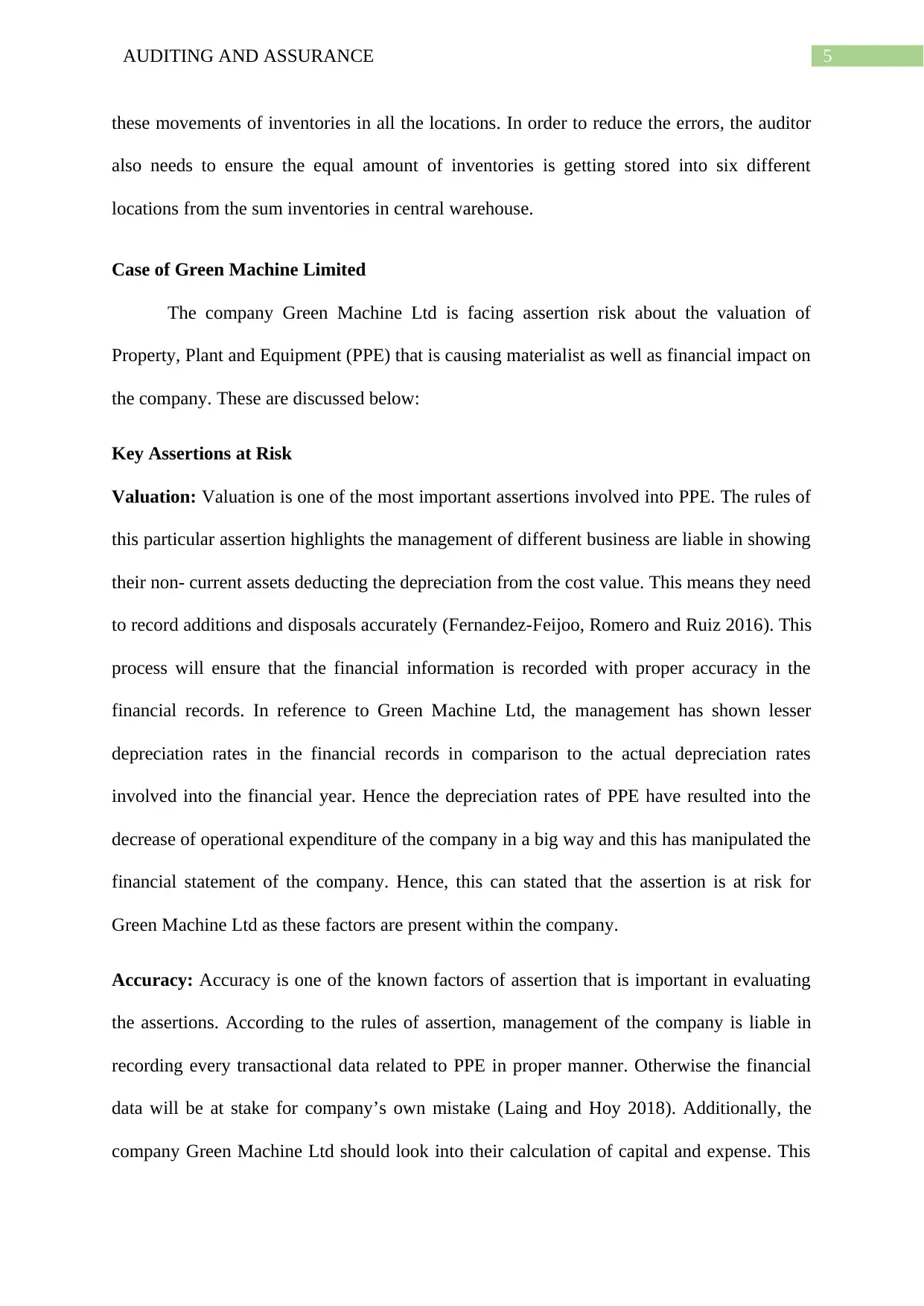
5AUDITING AND ASSURANCE
these movements of inventories in all the locations. In order to reduce the errors, the auditor
also needs to ensure the equal amount of inventories is getting stored into six different
locations from the sum inventories in central warehouse.
Case of Green Machine Limited
The company Green Machine Ltd is facing assertion risk about the valuation of
Property, Plant and Equipment (PPE) that is causing materialist as well as financial impact on
the company. These are discussed below:
Key Assertions at Risk
Valuation: Valuation is one of the most important assertions involved into PPE. The rules of
this particular assertion highlights the management of different business are liable in showing
their non- current assets deducting the depreciation from the cost value. This means they need
to record additions and disposals accurately (Fernandez-Feijoo, Romero and Ruiz 2016). This
process will ensure that the financial information is recorded with proper accuracy in the
financial records. In reference to Green Machine Ltd, the management has shown lesser
depreciation rates in the financial records in comparison to the actual depreciation rates
involved into the financial year. Hence the depreciation rates of PPE have resulted into the
decrease of operational expenditure of the company in a big way and this has manipulated the
financial statement of the company. Hence, this can stated that the assertion is at risk for
Green Machine Ltd as these factors are present within the company.
Accuracy: Accuracy is one of the known factors of assertion that is important in evaluating
the assertions. According to the rules of assertion, management of the company is liable in
recording every transactional data related to PPE in proper manner. Otherwise the financial
data will be at stake for company’s own mistake (Laing and Hoy 2018). Additionally, the
company Green Machine Ltd should look into their calculation of capital and expense. This
these movements of inventories in all the locations. In order to reduce the errors, the auditor
also needs to ensure the equal amount of inventories is getting stored into six different
locations from the sum inventories in central warehouse.
Case of Green Machine Limited
The company Green Machine Ltd is facing assertion risk about the valuation of
Property, Plant and Equipment (PPE) that is causing materialist as well as financial impact on
the company. These are discussed below:
Key Assertions at Risk
Valuation: Valuation is one of the most important assertions involved into PPE. The rules of
this particular assertion highlights the management of different business are liable in showing
their non- current assets deducting the depreciation from the cost value. This means they need
to record additions and disposals accurately (Fernandez-Feijoo, Romero and Ruiz 2016). This
process will ensure that the financial information is recorded with proper accuracy in the
financial records. In reference to Green Machine Ltd, the management has shown lesser
depreciation rates in the financial records in comparison to the actual depreciation rates
involved into the financial year. Hence the depreciation rates of PPE have resulted into the
decrease of operational expenditure of the company in a big way and this has manipulated the
financial statement of the company. Hence, this can stated that the assertion is at risk for
Green Machine Ltd as these factors are present within the company.
Accuracy: Accuracy is one of the known factors of assertion that is important in evaluating
the assertions. According to the rules of assertion, management of the company is liable in
recording every transactional data related to PPE in proper manner. Otherwise the financial
data will be at stake for company’s own mistake (Laing and Hoy 2018). Additionally, the
company Green Machine Ltd should look into their calculation of capital and expense. This
⊘ This is a preview!⊘
Do you want full access?
Subscribe today to unlock all pages.

Trusted by 1+ million students worldwide
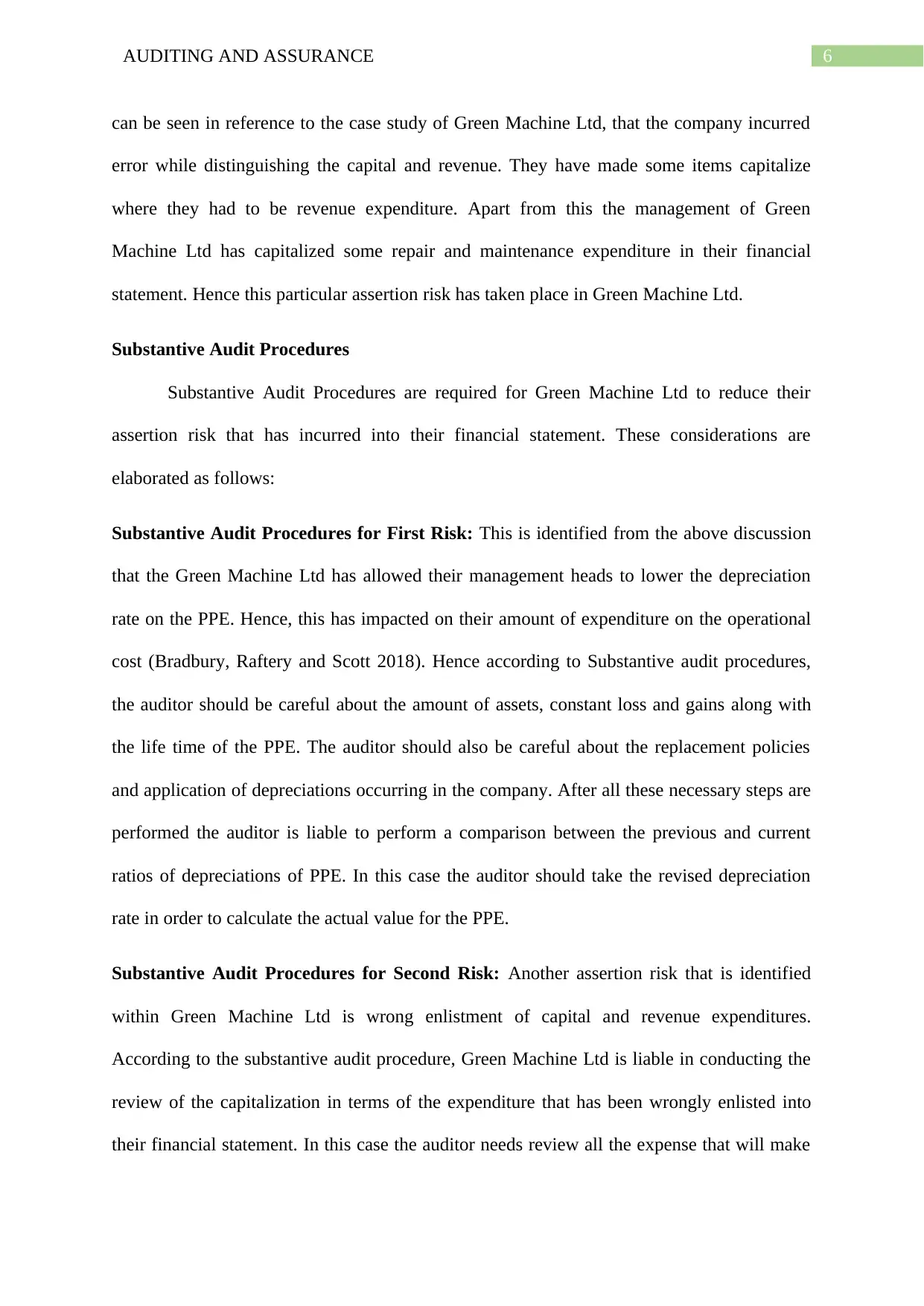
6AUDITING AND ASSURANCE
can be seen in reference to the case study of Green Machine Ltd, that the company incurred
error while distinguishing the capital and revenue. They have made some items capitalize
where they had to be revenue expenditure. Apart from this the management of Green
Machine Ltd has capitalized some repair and maintenance expenditure in their financial
statement. Hence this particular assertion risk has taken place in Green Machine Ltd.
Substantive Audit Procedures
Substantive Audit Procedures are required for Green Machine Ltd to reduce their
assertion risk that has incurred into their financial statement. These considerations are
elaborated as follows:
Substantive Audit Procedures for First Risk: This is identified from the above discussion
that the Green Machine Ltd has allowed their management heads to lower the depreciation
rate on the PPE. Hence, this has impacted on their amount of expenditure on the operational
cost (Bradbury, Raftery and Scott 2018). Hence according to Substantive audit procedures,
the auditor should be careful about the amount of assets, constant loss and gains along with
the life time of the PPE. The auditor should also be careful about the replacement policies
and application of depreciations occurring in the company. After all these necessary steps are
performed the auditor is liable to perform a comparison between the previous and current
ratios of depreciations of PPE. In this case the auditor should take the revised depreciation
rate in order to calculate the actual value for the PPE.
Substantive Audit Procedures for Second Risk: Another assertion risk that is identified
within Green Machine Ltd is wrong enlistment of capital and revenue expenditures.
According to the substantive audit procedure, Green Machine Ltd is liable in conducting the
review of the capitalization in terms of the expenditure that has been wrongly enlisted into
their financial statement. In this case the auditor needs review all the expense that will make
can be seen in reference to the case study of Green Machine Ltd, that the company incurred
error while distinguishing the capital and revenue. They have made some items capitalize
where they had to be revenue expenditure. Apart from this the management of Green
Machine Ltd has capitalized some repair and maintenance expenditure in their financial
statement. Hence this particular assertion risk has taken place in Green Machine Ltd.
Substantive Audit Procedures
Substantive Audit Procedures are required for Green Machine Ltd to reduce their
assertion risk that has incurred into their financial statement. These considerations are
elaborated as follows:
Substantive Audit Procedures for First Risk: This is identified from the above discussion
that the Green Machine Ltd has allowed their management heads to lower the depreciation
rate on the PPE. Hence, this has impacted on their amount of expenditure on the operational
cost (Bradbury, Raftery and Scott 2018). Hence according to Substantive audit procedures,
the auditor should be careful about the amount of assets, constant loss and gains along with
the life time of the PPE. The auditor should also be careful about the replacement policies
and application of depreciations occurring in the company. After all these necessary steps are
performed the auditor is liable to perform a comparison between the previous and current
ratios of depreciations of PPE. In this case the auditor should take the revised depreciation
rate in order to calculate the actual value for the PPE.
Substantive Audit Procedures for Second Risk: Another assertion risk that is identified
within Green Machine Ltd is wrong enlistment of capital and revenue expenditures.
According to the substantive audit procedure, Green Machine Ltd is liable in conducting the
review of the capitalization in terms of the expenditure that has been wrongly enlisted into
their financial statement. In this case the auditor needs review all the expense that will make
Paraphrase This Document
Need a fresh take? Get an instant paraphrase of this document with our AI Paraphraser
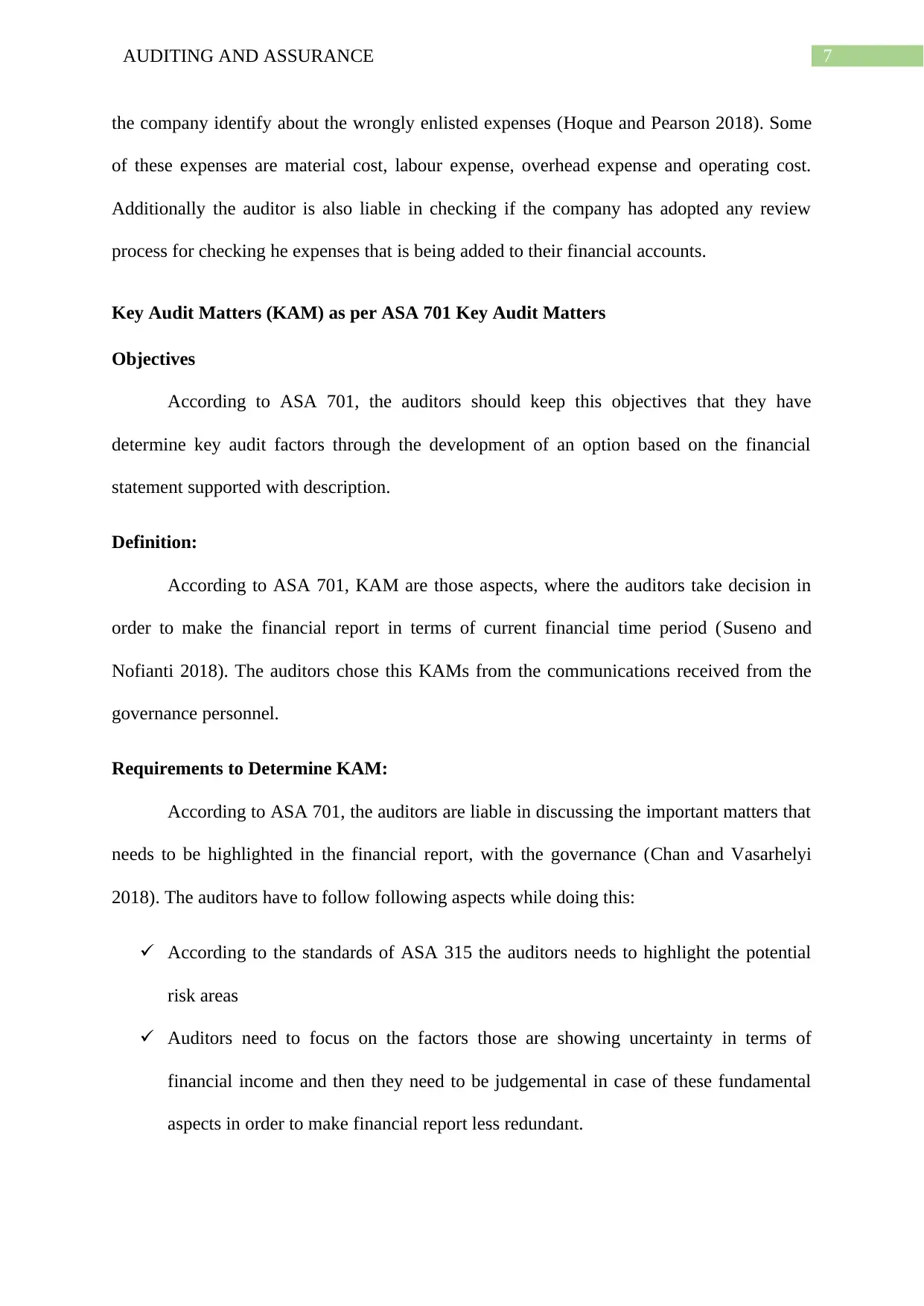
7AUDITING AND ASSURANCE
the company identify about the wrongly enlisted expenses (Hoque and Pearson 2018). Some
of these expenses are material cost, labour expense, overhead expense and operating cost.
Additionally the auditor is also liable in checking if the company has adopted any review
process for checking he expenses that is being added to their financial accounts.
Key Audit Matters (KAM) as per ASA 701 Key Audit Matters
Objectives
According to ASA 701, the auditors should keep this objectives that they have
determine key audit factors through the development of an option based on the financial
statement supported with description.
Definition:
According to ASA 701, KAM are those aspects, where the auditors take decision in
order to make the financial report in terms of current financial time period (Suseno and
Nofianti 2018). The auditors chose this KAMs from the communications received from the
governance personnel.
Requirements to Determine KAM:
According to ASA 701, the auditors are liable in discussing the important matters that
needs to be highlighted in the financial report, with the governance (Chan and Vasarhelyi
2018). The auditors have to follow following aspects while doing this:
According to the standards of ASA 315 the auditors needs to highlight the potential
risk areas
Auditors need to focus on the factors those are showing uncertainty in terms of
financial income and then they need to be judgemental in case of these fundamental
aspects in order to make financial report less redundant.
the company identify about the wrongly enlisted expenses (Hoque and Pearson 2018). Some
of these expenses are material cost, labour expense, overhead expense and operating cost.
Additionally the auditor is also liable in checking if the company has adopted any review
process for checking he expenses that is being added to their financial accounts.
Key Audit Matters (KAM) as per ASA 701 Key Audit Matters
Objectives
According to ASA 701, the auditors should keep this objectives that they have
determine key audit factors through the development of an option based on the financial
statement supported with description.
Definition:
According to ASA 701, KAM are those aspects, where the auditors take decision in
order to make the financial report in terms of current financial time period (Suseno and
Nofianti 2018). The auditors chose this KAMs from the communications received from the
governance personnel.
Requirements to Determine KAM:
According to ASA 701, the auditors are liable in discussing the important matters that
needs to be highlighted in the financial report, with the governance (Chan and Vasarhelyi
2018). The auditors have to follow following aspects while doing this:
According to the standards of ASA 315 the auditors needs to highlight the potential
risk areas
Auditors need to focus on the factors those are showing uncertainty in terms of
financial income and then they need to be judgemental in case of these fundamental
aspects in order to make financial report less redundant.
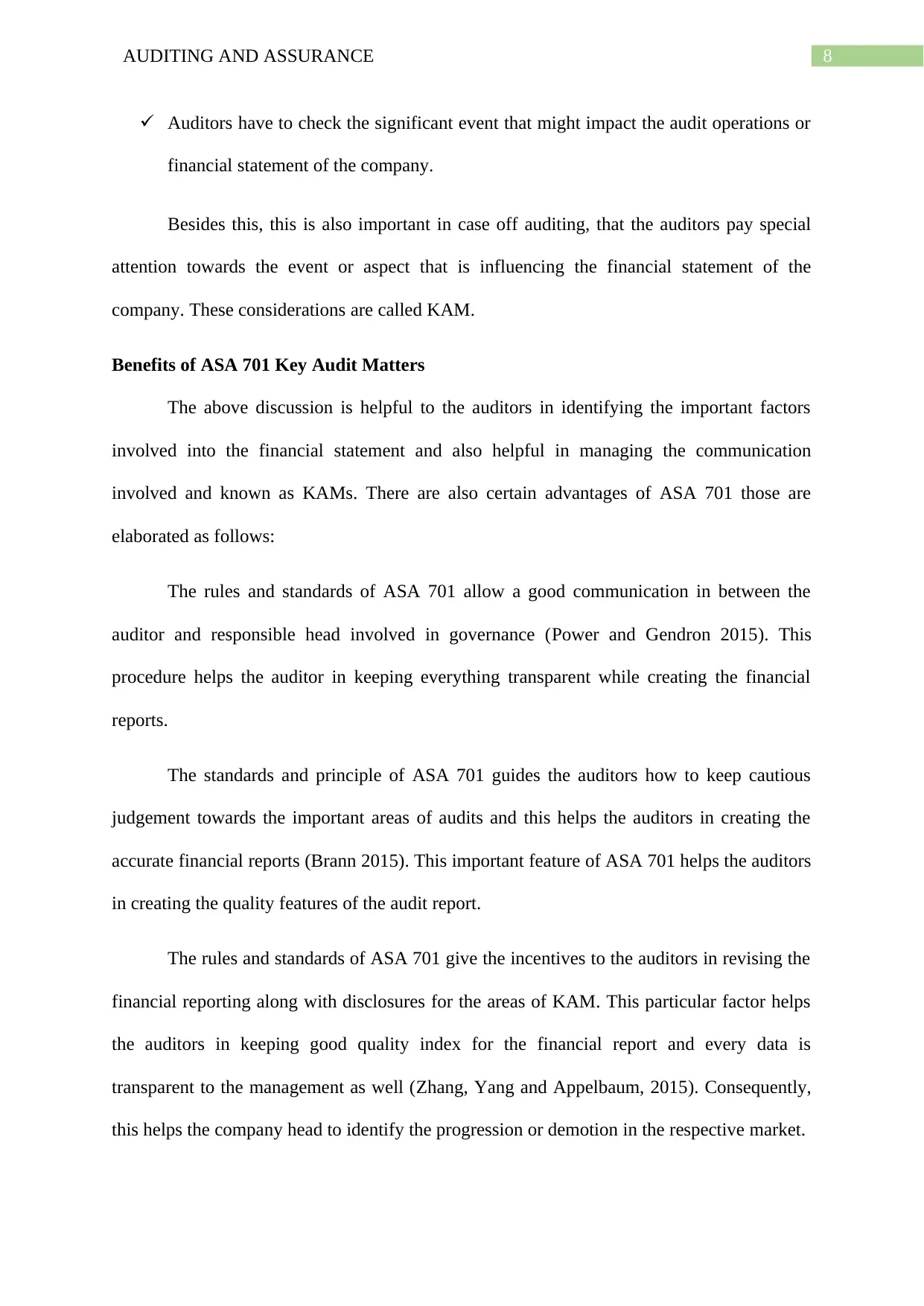
8AUDITING AND ASSURANCE
Auditors have to check the significant event that might impact the audit operations or
financial statement of the company.
Besides this, this is also important in case off auditing, that the auditors pay special
attention towards the event or aspect that is influencing the financial statement of the
company. These considerations are called KAM.
Benefits of ASA 701 Key Audit Matters
The above discussion is helpful to the auditors in identifying the important factors
involved into the financial statement and also helpful in managing the communication
involved and known as KAMs. There are also certain advantages of ASA 701 those are
elaborated as follows:
The rules and standards of ASA 701 allow a good communication in between the
auditor and responsible head involved in governance (Power and Gendron 2015). This
procedure helps the auditor in keeping everything transparent while creating the financial
reports.
The standards and principle of ASA 701 guides the auditors how to keep cautious
judgement towards the important areas of audits and this helps the auditors in creating the
accurate financial reports (Brann 2015). This important feature of ASA 701 helps the auditors
in creating the quality features of the audit report.
The rules and standards of ASA 701 give the incentives to the auditors in revising the
financial reporting along with disclosures for the areas of KAM. This particular factor helps
the auditors in keeping good quality index for the financial report and every data is
transparent to the management as well (Zhang, Yang and Appelbaum, 2015). Consequently,
this helps the company head to identify the progression or demotion in the respective market.
Auditors have to check the significant event that might impact the audit operations or
financial statement of the company.
Besides this, this is also important in case off auditing, that the auditors pay special
attention towards the event or aspect that is influencing the financial statement of the
company. These considerations are called KAM.
Benefits of ASA 701 Key Audit Matters
The above discussion is helpful to the auditors in identifying the important factors
involved into the financial statement and also helpful in managing the communication
involved and known as KAMs. There are also certain advantages of ASA 701 those are
elaborated as follows:
The rules and standards of ASA 701 allow a good communication in between the
auditor and responsible head involved in governance (Power and Gendron 2015). This
procedure helps the auditor in keeping everything transparent while creating the financial
reports.
The standards and principle of ASA 701 guides the auditors how to keep cautious
judgement towards the important areas of audits and this helps the auditors in creating the
accurate financial reports (Brann 2015). This important feature of ASA 701 helps the auditors
in creating the quality features of the audit report.
The rules and standards of ASA 701 give the incentives to the auditors in revising the
financial reporting along with disclosures for the areas of KAM. This particular factor helps
the auditors in keeping good quality index for the financial report and every data is
transparent to the management as well (Zhang, Yang and Appelbaum, 2015). Consequently,
this helps the company head to identify the progression or demotion in the respective market.
⊘ This is a preview!⊘
Do you want full access?
Subscribe today to unlock all pages.

Trusted by 1+ million students worldwide
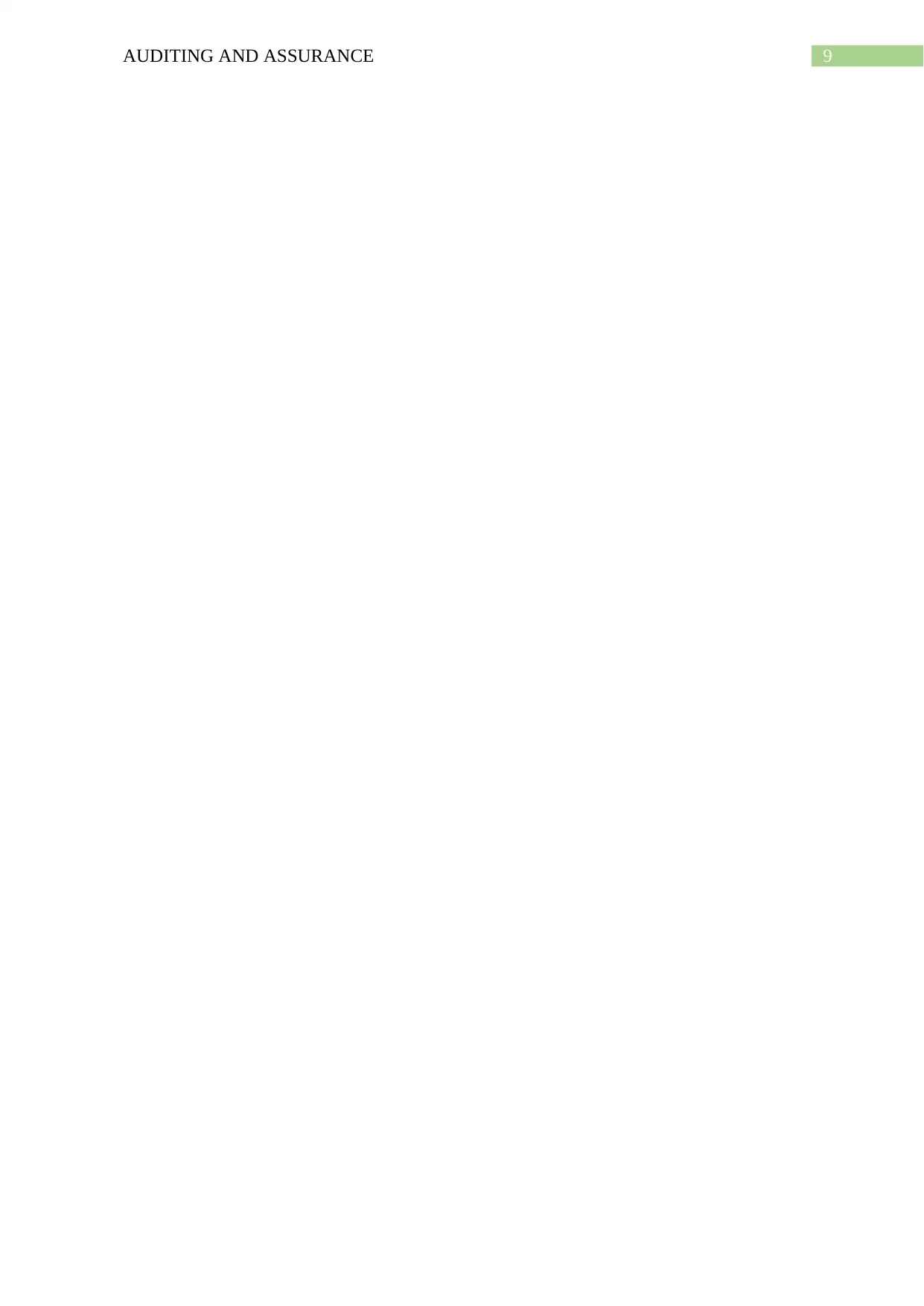
9AUDITING AND ASSURANCE
Paraphrase This Document
Need a fresh take? Get an instant paraphrase of this document with our AI Paraphraser

10AUDITING AND ASSURANCE
Reasons for selecting Key Audit Matters:
The selection of Key Audit Matters for Advance Computer Solutions and Green
Machine Ltd is stated below:
Case study of Advance Computer Solution:
As noticed in the case of Advance Computer Solution the motive selecting the key
audit matters is the risks associated to the valuation of inventory by the company which may
lead to material misstatement in fiscal reports (Amir-Mohammadian, Chong and Skalka
2016). The material misstatement may lead to incorrect interpretation of financial standing
for the business. Additionally, it is noticed that the management are involved in judging the
inventory valuation procedure that involves greater uncertainty and lower transparency which
may result in material misstatement in financial reports.
Case study of Green Machines Ltd:
With reference to ASA 701 in case of Green Machines Ltd there is an existence of
material misstatement. Primarily it is noticed that the company charged very lower
depreciation rate on the property plant and equipment which may understate the depreciation
expenses for the business and might understate the profit made during period (Arena and
Jeppesen 2016). As a result this gives rise to material misstatement in the financial reports of
Green Machines Ltd. Secondly there is mistake in classifying the capital and revenue
expenses which might overstate or understate the profitability for Green Machines Ltd during
that period. The error in judgement of capital and revenue expenses as well as lower charging
of depreciation may lead to material misstatement of financial standing and this forms the
main factor in considering them under key audit matters.
Reasons for selecting Key Audit Matters:
The selection of Key Audit Matters for Advance Computer Solutions and Green
Machine Ltd is stated below:
Case study of Advance Computer Solution:
As noticed in the case of Advance Computer Solution the motive selecting the key
audit matters is the risks associated to the valuation of inventory by the company which may
lead to material misstatement in fiscal reports (Amir-Mohammadian, Chong and Skalka
2016). The material misstatement may lead to incorrect interpretation of financial standing
for the business. Additionally, it is noticed that the management are involved in judging the
inventory valuation procedure that involves greater uncertainty and lower transparency which
may result in material misstatement in financial reports.
Case study of Green Machines Ltd:
With reference to ASA 701 in case of Green Machines Ltd there is an existence of
material misstatement. Primarily it is noticed that the company charged very lower
depreciation rate on the property plant and equipment which may understate the depreciation
expenses for the business and might understate the profit made during period (Arena and
Jeppesen 2016). As a result this gives rise to material misstatement in the financial reports of
Green Machines Ltd. Secondly there is mistake in classifying the capital and revenue
expenses which might overstate or understate the profitability for Green Machines Ltd during
that period. The error in judgement of capital and revenue expenses as well as lower charging
of depreciation may lead to material misstatement of financial standing and this forms the
main factor in considering them under key audit matters.
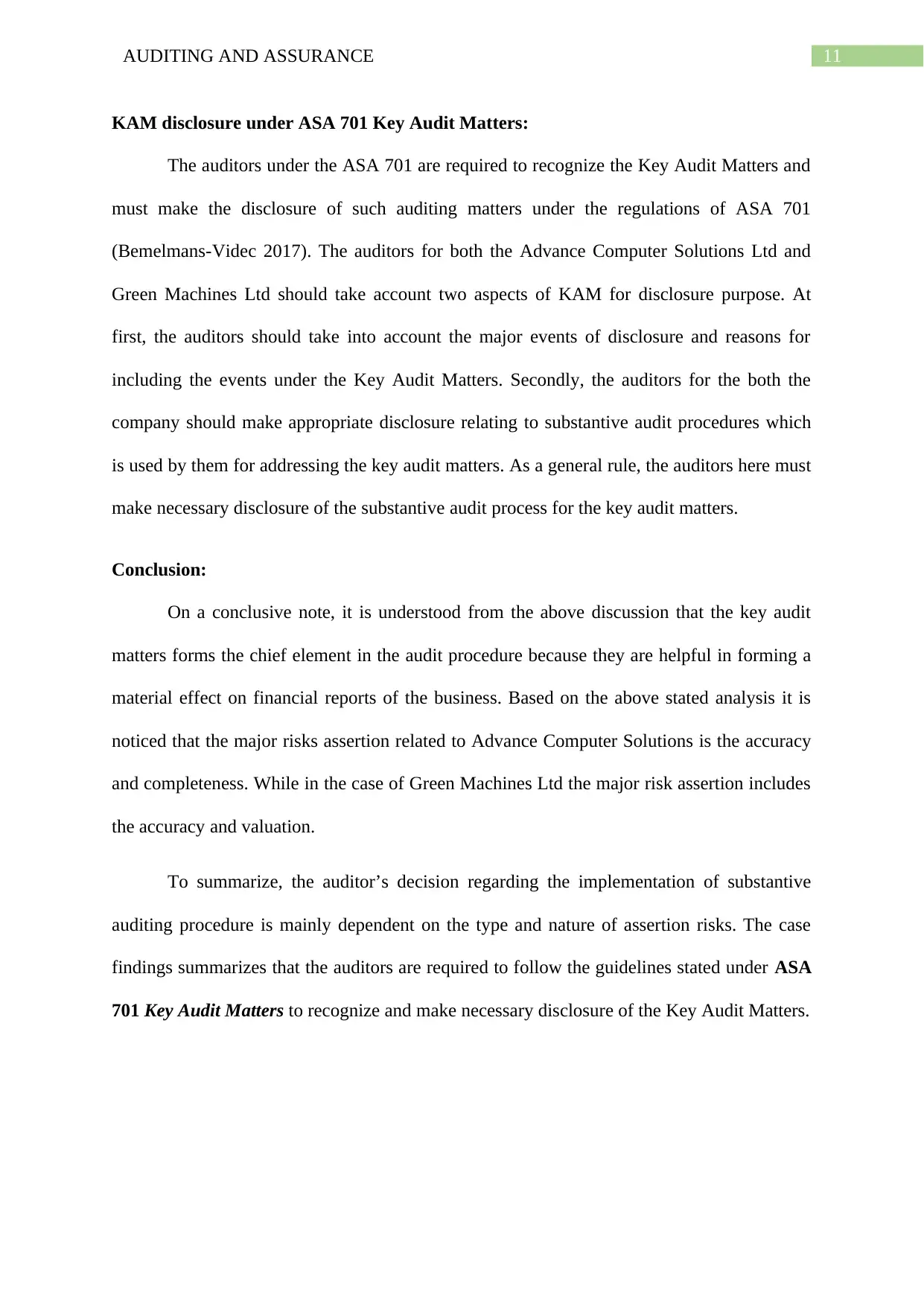
11AUDITING AND ASSURANCE
KAM disclosure under ASA 701 Key Audit Matters:
The auditors under the ASA 701 are required to recognize the Key Audit Matters and
must make the disclosure of such auditing matters under the regulations of ASA 701
(Bemelmans-Videc 2017). The auditors for both the Advance Computer Solutions Ltd and
Green Machines Ltd should take account two aspects of KAM for disclosure purpose. At
first, the auditors should take into account the major events of disclosure and reasons for
including the events under the Key Audit Matters. Secondly, the auditors for the both the
company should make appropriate disclosure relating to substantive audit procedures which
is used by them for addressing the key audit matters. As a general rule, the auditors here must
make necessary disclosure of the substantive audit process for the key audit matters.
Conclusion:
On a conclusive note, it is understood from the above discussion that the key audit
matters forms the chief element in the audit procedure because they are helpful in forming a
material effect on financial reports of the business. Based on the above stated analysis it is
noticed that the major risks assertion related to Advance Computer Solutions is the accuracy
and completeness. While in the case of Green Machines Ltd the major risk assertion includes
the accuracy and valuation.
To summarize, the auditor’s decision regarding the implementation of substantive
auditing procedure is mainly dependent on the type and nature of assertion risks. The case
findings summarizes that the auditors are required to follow the guidelines stated under ASA
701 Key Audit Matters to recognize and make necessary disclosure of the Key Audit Matters.
KAM disclosure under ASA 701 Key Audit Matters:
The auditors under the ASA 701 are required to recognize the Key Audit Matters and
must make the disclosure of such auditing matters under the regulations of ASA 701
(Bemelmans-Videc 2017). The auditors for both the Advance Computer Solutions Ltd and
Green Machines Ltd should take account two aspects of KAM for disclosure purpose. At
first, the auditors should take into account the major events of disclosure and reasons for
including the events under the Key Audit Matters. Secondly, the auditors for the both the
company should make appropriate disclosure relating to substantive audit procedures which
is used by them for addressing the key audit matters. As a general rule, the auditors here must
make necessary disclosure of the substantive audit process for the key audit matters.
Conclusion:
On a conclusive note, it is understood from the above discussion that the key audit
matters forms the chief element in the audit procedure because they are helpful in forming a
material effect on financial reports of the business. Based on the above stated analysis it is
noticed that the major risks assertion related to Advance Computer Solutions is the accuracy
and completeness. While in the case of Green Machines Ltd the major risk assertion includes
the accuracy and valuation.
To summarize, the auditor’s decision regarding the implementation of substantive
auditing procedure is mainly dependent on the type and nature of assertion risks. The case
findings summarizes that the auditors are required to follow the guidelines stated under ASA
701 Key Audit Matters to recognize and make necessary disclosure of the Key Audit Matters.
⊘ This is a preview!⊘
Do you want full access?
Subscribe today to unlock all pages.

Trusted by 1+ million students worldwide
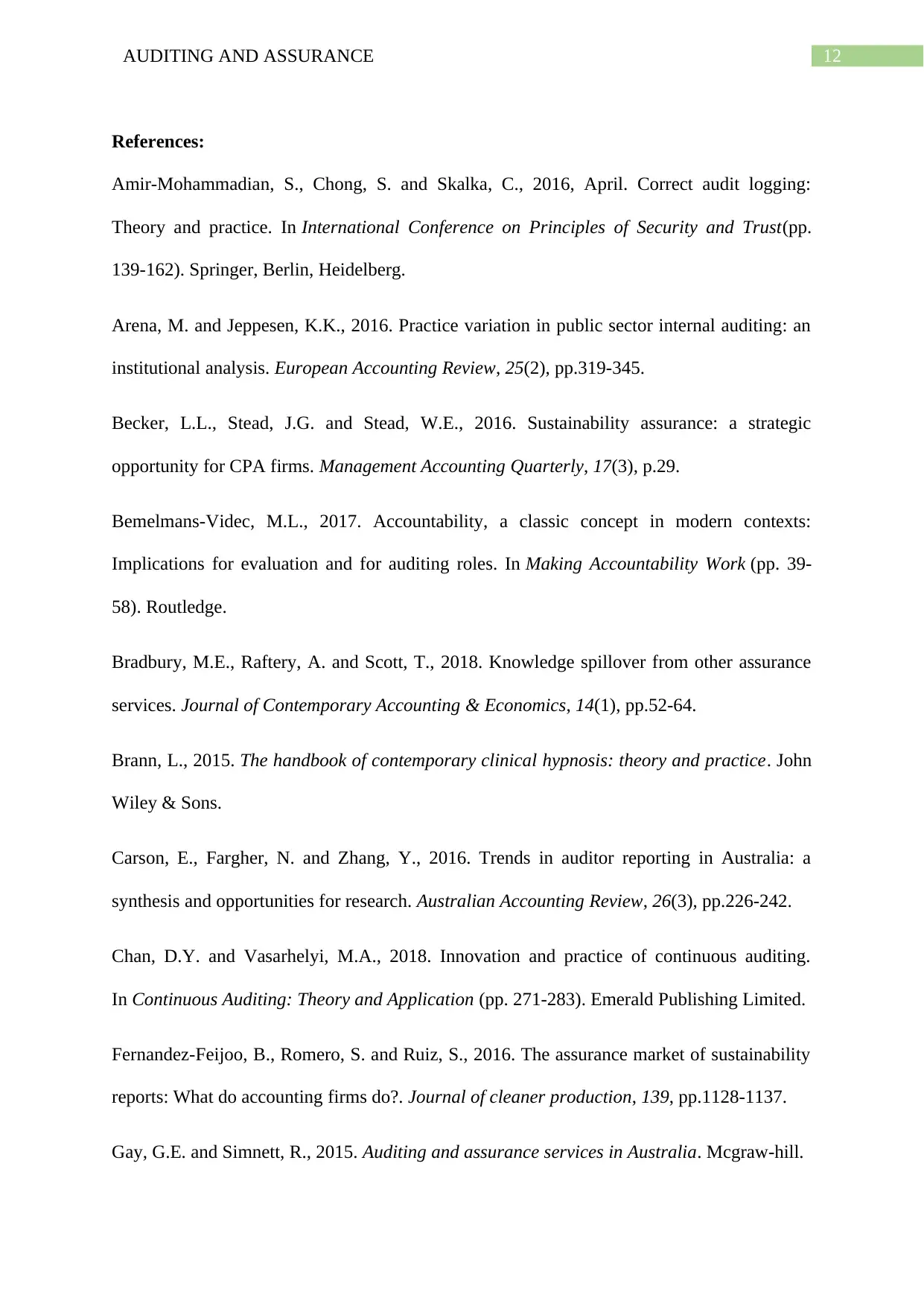
12AUDITING AND ASSURANCE
References:
Amir-Mohammadian, S., Chong, S. and Skalka, C., 2016, April. Correct audit logging:
Theory and practice. In International Conference on Principles of Security and Trust(pp.
139-162). Springer, Berlin, Heidelberg.
Arena, M. and Jeppesen, K.K., 2016. Practice variation in public sector internal auditing: an
institutional analysis. European Accounting Review, 25(2), pp.319-345.
Becker, L.L., Stead, J.G. and Stead, W.E., 2016. Sustainability assurance: a strategic
opportunity for CPA firms. Management Accounting Quarterly, 17(3), p.29.
Bemelmans-Videc, M.L., 2017. Accountability, a classic concept in modern contexts:
Implications for evaluation and for auditing roles. In Making Accountability Work (pp. 39-
58). Routledge.
Bradbury, M.E., Raftery, A. and Scott, T., 2018. Knowledge spillover from other assurance
services. Journal of Contemporary Accounting & Economics, 14(1), pp.52-64.
Brann, L., 2015. The handbook of contemporary clinical hypnosis: theory and practice. John
Wiley & Sons.
Carson, E., Fargher, N. and Zhang, Y., 2016. Trends in auditor reporting in Australia: a
synthesis and opportunities for research. Australian Accounting Review, 26(3), pp.226-242.
Chan, D.Y. and Vasarhelyi, M.A., 2018. Innovation and practice of continuous auditing.
In Continuous Auditing: Theory and Application (pp. 271-283). Emerald Publishing Limited.
Fernandez-Feijoo, B., Romero, S. and Ruiz, S., 2016. The assurance market of sustainability
reports: What do accounting firms do?. Journal of cleaner production, 139, pp.1128-1137.
Gay, G.E. and Simnett, R., 2015. Auditing and assurance services in Australia. Mcgraw-hill.
References:
Amir-Mohammadian, S., Chong, S. and Skalka, C., 2016, April. Correct audit logging:
Theory and practice. In International Conference on Principles of Security and Trust(pp.
139-162). Springer, Berlin, Heidelberg.
Arena, M. and Jeppesen, K.K., 2016. Practice variation in public sector internal auditing: an
institutional analysis. European Accounting Review, 25(2), pp.319-345.
Becker, L.L., Stead, J.G. and Stead, W.E., 2016. Sustainability assurance: a strategic
opportunity for CPA firms. Management Accounting Quarterly, 17(3), p.29.
Bemelmans-Videc, M.L., 2017. Accountability, a classic concept in modern contexts:
Implications for evaluation and for auditing roles. In Making Accountability Work (pp. 39-
58). Routledge.
Bradbury, M.E., Raftery, A. and Scott, T., 2018. Knowledge spillover from other assurance
services. Journal of Contemporary Accounting & Economics, 14(1), pp.52-64.
Brann, L., 2015. The handbook of contemporary clinical hypnosis: theory and practice. John
Wiley & Sons.
Carson, E., Fargher, N. and Zhang, Y., 2016. Trends in auditor reporting in Australia: a
synthesis and opportunities for research. Australian Accounting Review, 26(3), pp.226-242.
Chan, D.Y. and Vasarhelyi, M.A., 2018. Innovation and practice of continuous auditing.
In Continuous Auditing: Theory and Application (pp. 271-283). Emerald Publishing Limited.
Fernandez-Feijoo, B., Romero, S. and Ruiz, S., 2016. The assurance market of sustainability
reports: What do accounting firms do?. Journal of cleaner production, 139, pp.1128-1137.
Gay, G.E. and Simnett, R., 2015. Auditing and assurance services in Australia. Mcgraw-hill.
Paraphrase This Document
Need a fresh take? Get an instant paraphrase of this document with our AI Paraphraser
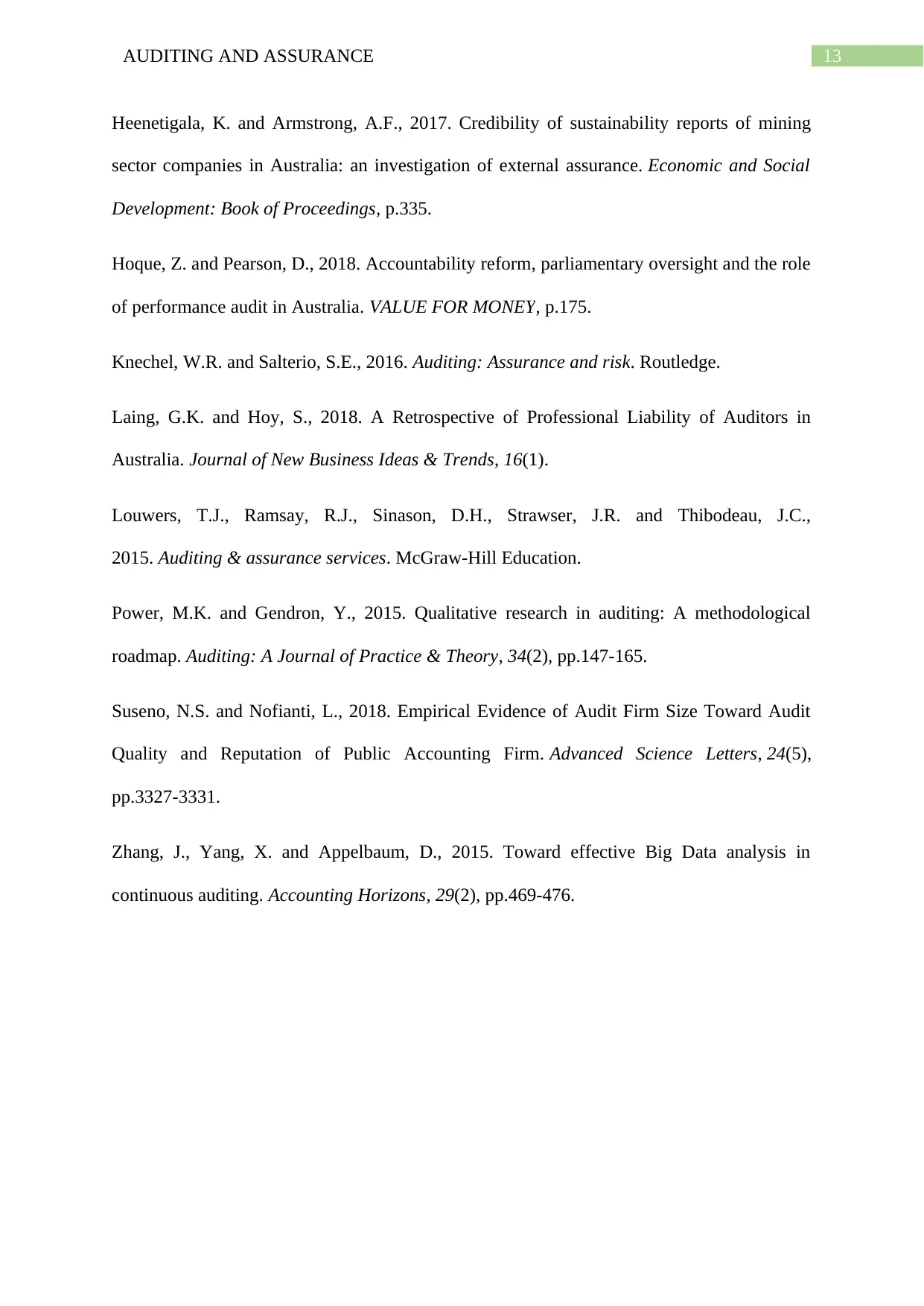
13AUDITING AND ASSURANCE
Heenetigala, K. and Armstrong, A.F., 2017. Credibility of sustainability reports of mining
sector companies in Australia: an investigation of external assurance. Economic and Social
Development: Book of Proceedings, p.335.
Hoque, Z. and Pearson, D., 2018. Accountability reform, parliamentary oversight and the role
of performance audit in Australia. VALUE FOR MONEY, p.175.
Knechel, W.R. and Salterio, S.E., 2016. Auditing: Assurance and risk. Routledge.
Laing, G.K. and Hoy, S., 2018. A Retrospective of Professional Liability of Auditors in
Australia. Journal of New Business Ideas & Trends, 16(1).
Louwers, T.J., Ramsay, R.J., Sinason, D.H., Strawser, J.R. and Thibodeau, J.C.,
2015. Auditing & assurance services. McGraw-Hill Education.
Power, M.K. and Gendron, Y., 2015. Qualitative research in auditing: A methodological
roadmap. Auditing: A Journal of Practice & Theory, 34(2), pp.147-165.
Suseno, N.S. and Nofianti, L., 2018. Empirical Evidence of Audit Firm Size Toward Audit
Quality and Reputation of Public Accounting Firm. Advanced Science Letters, 24(5),
pp.3327-3331.
Zhang, J., Yang, X. and Appelbaum, D., 2015. Toward effective Big Data analysis in
continuous auditing. Accounting Horizons, 29(2), pp.469-476.
Heenetigala, K. and Armstrong, A.F., 2017. Credibility of sustainability reports of mining
sector companies in Australia: an investigation of external assurance. Economic and Social
Development: Book of Proceedings, p.335.
Hoque, Z. and Pearson, D., 2018. Accountability reform, parliamentary oversight and the role
of performance audit in Australia. VALUE FOR MONEY, p.175.
Knechel, W.R. and Salterio, S.E., 2016. Auditing: Assurance and risk. Routledge.
Laing, G.K. and Hoy, S., 2018. A Retrospective of Professional Liability of Auditors in
Australia. Journal of New Business Ideas & Trends, 16(1).
Louwers, T.J., Ramsay, R.J., Sinason, D.H., Strawser, J.R. and Thibodeau, J.C.,
2015. Auditing & assurance services. McGraw-Hill Education.
Power, M.K. and Gendron, Y., 2015. Qualitative research in auditing: A methodological
roadmap. Auditing: A Journal of Practice & Theory, 34(2), pp.147-165.
Suseno, N.S. and Nofianti, L., 2018. Empirical Evidence of Audit Firm Size Toward Audit
Quality and Reputation of Public Accounting Firm. Advanced Science Letters, 24(5),
pp.3327-3331.
Zhang, J., Yang, X. and Appelbaum, D., 2015. Toward effective Big Data analysis in
continuous auditing. Accounting Horizons, 29(2), pp.469-476.
1 out of 14
Related Documents
Your All-in-One AI-Powered Toolkit for Academic Success.
+13062052269
info@desklib.com
Available 24*7 on WhatsApp / Email
![[object Object]](/_next/static/media/star-bottom.7253800d.svg)
Unlock your academic potential
© 2024 | Zucol Services PVT LTD | All rights reserved.





